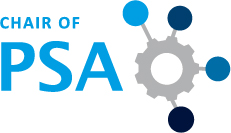Scientific news ticker february 2017
Agent systems in factory automation
February 2017 For many years, agent systems have been investigated as a design paradigm and as an implementation technology. As a result, a large number of agent-based control architectures have been developed which benefit from the advantages of the agent systems to deal with existing problems in factory automation. These efforts are documented, for example, in VDI Guidelines 2653- "Agent Systems in Automation Technology" and in publications such as “Agentensysteme in der Automatisierungstechnik (Agent Systems in Automation Technology)“ von P. Göhner (Editor) by P. Göhner (Editor) and “Industrial Agents: Emerging Applications of Software Agents in Industry“ von P. Leitão und S. Karnouskos, to which the IAF has contributed. In the last 3 years, the IAF has taken a further step (in this case in particular through the work of Dipl.-Ing. Daria Ryashentseva).
The starting point of the work were the questions concerning the flexibility of production systems addressed to the industry 4.0. Each production system component should adapt itself to the changing environmental conditions and manufacturing requirements and accordingly optimized carry out the production processes. However, this can not be achieved with the existing automation structures.
Figure 1: Existing challenges for production systems
As a special challenge could be identified:
- the distribution of control decisions to cooperating systems,
- the automatic change of the control of production processes through the integrated controls and
- the use of product descriptions to trigger this change.
However, it is not reasonable to assume that existing control systems can be replaced in one step by new control systems. On the contrary, the new control systems must be able to be developed and implemented through migration from the existing ones, as an extension of existing control systems.
The Supervisory Control Theory, developed by Ramadge and Wonham, could be identified as a useful basis for implementing an extension of existing control architectures. This postulates the existence of a controlled system in the sense of a closed control circuit whose behavior is restricted by a supervisor or adapted to the changesof requirements. The structure shown in Figure 2 can be applied to various levels of automation pyramid. It differs only regarding the information used for control decisions and their influence on the controlled system.
Looking at the field level, the need for adaptation of a controlled system refers to the process to be executed/ carried out (in the case of factory automation, the production process within a resource). Here, the process parameters must be adapted to the process necessary to produce the product.
Figure 2: Supervisor architecture at the field level
The MES or ERP level, on the other hand, deals with the organizational structure of the interaction of the various resources in the production system. This must be adapted to the production process sequence required for the product.
To implement this supervisor architecture, Ms. Ryashentseva has developed an architecture which is based on five agents, shown in Figure 3.
Figure 3: Supervisor based control architecture
It consists of the following agents:
- The Executive Agent is used to access to the underlying control system, which is controlled by a conventional controller. It thus implements the adaptation of the controlled system to the changed requirements of a product or its environment.
- The Supervisor Agent makes the decisions about adapting the controlled system. It collects all available or necessary information for it.
- The High-availability Agent monitors the environment of the entire system, providing the Supervisor Agent with information about control-related events.
- The Rescheduler Agent supports the supervisor agent by performing necessary calculations, such as determining new work plans.
- The dispatcher agent includes a knowledge base with information relevant to the decision of the supervisor agent.
In the case of three applications, Ms. Ryashentseva proves the advantages of the control architecture in her dissertation "Agents and SCT based self * control architecture for production systems". One of the examples relates to a laboratory facility located at the IAF. For this, the agent architecture shown in Figure 4 has been implemented.
Figure 4: Realisation of the Example
With the control architecture developed by Ms Ryashentseva at the IAF, the necessary flexibility of production systems, as sought in industry 4.0, can be addressed. The five developed agents can be viewed as a possible realization for a management layer of an industry 4.0 component.
The architectures developed during the promotion of Ms. Ryashentseva is currently being implemented by the IAF in the revision of the VDI Directive 2653. Here, in particular, (well-)known fields of application of agent-based controlling and the resulted design patterns are relevant, which are currently being developed at the IAF.
Contact: apl. Prof. Dr.-Ing. habil. Arndt Lüder






